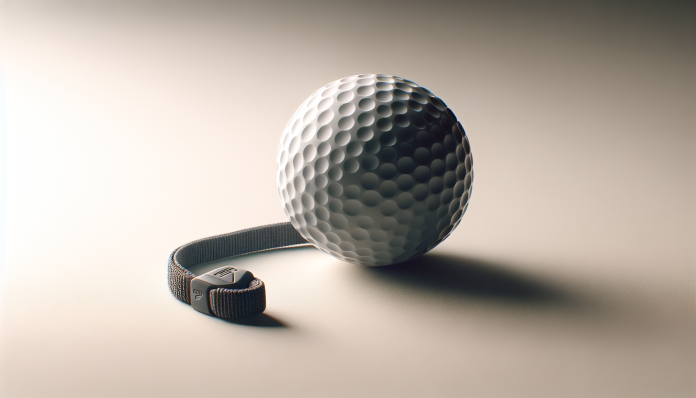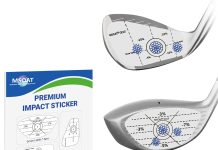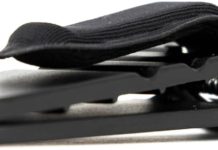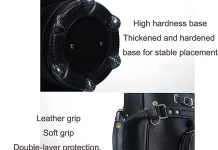Have you ever wished for a small, portable tool that could actually help me fix my swing and make my practice more productive?
Product Overview
I picked up the Golf Trainer Ball, Portable and Lightweight Golf Swing Posture Corrector, Golf Smart Ball, Golf Training Aid Balls for Beginner Golfer Men Women because I wanted a simple, feedback-driven way to improve my swing without hauling a bunch of gear to the driving range. The product promises timely feedback, portability, and an adjustable wrist strap so it sounded like a practical solution for on-the-go practice and focused repetition. I liked that it targets posture and rhythm—two things I often struggle with—so I expected straightforward, actionable corrections rather than complicated tech.
Golf Trainer Ball, Portable and Lightweight Golf Swing Posture Corrector, Golf Smart Ball, Golf Training Aid Balls for Beginner Golfer Men Women
First Impressions
When I first unboxed the Golf Trainer Ball I appreciated the lightweight feel and compact size; it immediately felt like something I could toss in my golf bag or even a carry-on. The design is intentionally simple, and that simplicity made it easy for me to start using it within minutes instead of spending time on setup or reading long manuals. I noticed the adjustable wrist strap right away and thought it would help keep the trainer in the right position throughout a swing, which is essential if the object is supposed to give accurate feedback.
Design and Build Quality
The build of the Golf Trainer Ball balances portability and sturdiness in a way that makes sense for a training aid. It isn’t heavy or ornate, which keeps the focus on practicing technique rather than handling a fragile gadget, and the material choices give a reassuringly durable feel without adding bulk. I found the surface texture to be grippy enough for practice without being abrasive, and the overall assembly looked like it could survive the knocks and bumps that come with regular use.
Size and Portability
The ball measures 9.5 centimeters in diameter, which makes it small enough to carry inside my golf bag or a backpack pocket with no problem. Because it’s only about the size of a small grapefruit, I could practice at home, in a park, or during a short break at work without needing a lot of space. The compact form factor made spontaneous practice sessions realistic—if I had a few minutes I could set it up and go, and that convenience increased how often I actually worked on my swing.
Materials and Durability
I noted that the Golf Trainer Ball uses materials that are light but resilient enough for repeated practice sessions. The surface resists scuffs and the internal strap attachments felt secure during my swings, which gave me confidence that it wouldn’t detach easily. Over several weeks of use I didn’t see any cracking or obvious wear, though I would still recommend keeping it away from extreme temperatures and avoiding stepping on it to extend its life. Overall, the construction feels thoughtful for a product meant to be portable and frequently handled.
Features and Performance
This trainer focuses on feedback during the swing, posture correction, and adjustability to fit different wrist sizes and swing styles. The feature set is deliberately straightforward: a ball sized for portability, an adjustable strap to control movement and position, and a design meant to cue your body about timing and wrist action. In use, the feedback comes more from feel and observation than from electronics, which can be a benefit if you prefer tactile coaching rather than screen-based analysis.
Swing Feedback and Posture Correction
What I liked most was how the Golf Trainer Ball gives immediate, tactile feedback—if my wrists were breaking down or my rhythm was off, the ball’s movement during the swing highlighted those faults in real time. That instant feedback let me self-correct during a session without waiting for a coach or video analysis. I found that focusing on how the ball tracked during slow, deliberate swings helped me identify and fix posture issues, particularly in the takeaway and transition phases where many amateurs lose consistency.
Adjustable Wrist Strap and Fit
The adjustable wrist strap ranges from 7 cm to 15 cm in diameter, and in practice that meant it fit comfortably on my hand and adjusted easily for different grip styles. I appreciated being able to tighten or loosen the strap to simulate different wrist resistance, which allowed me to practice more passive or more locked wrist positions depending on the drill. The strap’s fit stayed consistent during rep after rep, and I didn’t have to keep readjusting mid-session, which is a small but meaningful convenience.
Use Cases: Beginners to Pros
While the product is marketed heavily toward beginners, I found useful ways to incorporate it into intermediate practice routines as well. Beginners will benefit from the posture and wrist cues that create fast, measurable improvements in rhythm and basic swing mechanics. More experienced players can use it for targeted drills—such as fixing early wrist release or smoothing transition timing—although those players may prefer more advanced tools in addition to this ball for fine-grain analysis.
How It Compares to Other Training Aids
Compared to weighted clubs, alignment sticks, or high-tech swing analyzers, the Golf Trainer Ball occupies a middle ground: it’s more focused than a general-purpose tool and less complex than electronic systems. I liked that it offered portable, tactile correction without the need for batteries or software updates. It’s not designed to give data or numbers, but for many players, the physical feedback is enough to produce measurable improvement.
Versus Traditional Training Balls
Traditional training balls (or items like balance balls and weighted clubs) tend to either add resistance or demand whole-body balance adjustments. The Golf Trainer Ball instead emphasizes wrist and posture feedback without adding significant weight, which made my swing feel more natural while still correcting faults. I found it less intrusive than heavy training aids and simpler to use during short sessions.
Versus High-Tech Electronic Trainers
Compared with electronic swing analyzers that record metrics like clubhead speed and angle, the Golf Trainer Ball provides qualitative rather than quantitative feedback. I missed the data logs you get from apps, but I appreciated that there was no setup time or dependency on a phone connection. For players who want actionable feel-based coaching and aren’t obsessed with numbers, this ball is a practical alternative.
My Experience Using It
I used the Golf Trainer Ball over several weeks during warm-ups, short practice sessions, and focused drills intended to fix specific issues. My expectations were modest—improved rhythm and a cleaner wrist action—and over time I noticed measurable changes in ball-striking consistency and fewer errant shots in practice. The immediate sensory feedback made it easier to remember and maintain corrections during full swings.
Practice Sessions and Drills
I structured my sessions in short blocks: slow-motion warm-ups with the ball, half-speed rhythm drills, and then transitional swings where I’d incrementally increase speed while focusing on the feel of the ball. I used drills to isolate the takeaway and the transition because those are where my faults typically show up, and the ball made it easy to sense when my wrists were letting go too early. Mixing the ball work into normal range practice helped the corrected movements translate to my full swing.
Troubleshooting and Tips
At first I had a few awkward reps where the strap felt loose, so my tip is to adjust the strap firmly before starting and then re-check after several swings. If you’re practicing in windy conditions, keep in mind that wind can change the feel of light training aids, so I recommend sheltered areas for fine-tuning. Also, I found that using the ball in conjunction with mirror work or a short video clip of my swing accelerated learning—feel plus visual feedback speeds up the correction process.
Who This Is Best For
I think the Golf Trainer Ball is especially valuable for beginners who need a simple, portable tool to develop consistent rhythm and posture. It’s also appropriate for intermediate players who want to rework a specific mechanical habit like early wrist release or a too-steep takeaway. If you’re an advanced player focused on hardcore data, you may want to complement this ball with a swing analyzer, but the tactile feedback still has value even at higher skill levels.
Ideal Use Environments
This trainer works well in small indoor spaces, on the practice green, or at the driving range where there is enough room to swing without obstruction. I used it at home in a garage and in a local park with no issues, and the lightweight design made these stop-and-go practice moments practical. It’s not designed for playing on course in full rounds, but for focused practice sessions it’s extremely handy.
Gift Potential
The product’s friendly and straightforward nature makes it a practical present for golf lovers—especially those who are learning or trying to refine fundamentals. I’ve given similar training aids as presents and found they’re appreciated for being both useful and not overly technical, which fits many golfers who prefer tangible practice tools. The packaging and concept also hit a nice balance between thoughtful and practical for occasions like birthdays or holidays.
Maintenance and Care
Caring for the Golf Trainer Ball is simple: clean it with mild soap and water and store it in a cool, dry place when not in use. Because it’s portable, I sometimes kept it in an outer pocket of my golf bag; just be mindful to avoid crushing it under heavy gear. Routine inspections of the strap and attachments are a good habit—check for frays or loosening hardware to avoid mid-session failures.
Cleaning
I ran a damp cloth with mild detergent across the surface when it collected grass and dirt from practice sessions, and that removed grime without damaging the material. Avoid harsh chemicals or abrasive brushes, and let it air dry completely before packing it away to prevent moisture-related issues. Regular light cleaning will keep it looking new and functioning properly.
Storage
I stored mine loosely in a small compartment to avoid compressing the strap and to keep it from being punctured by sharp items. If you have a protective pouch, that’s a nice touch for travel; otherwise just keep it separate from clubs and tees to maintain its shape. Storing it indoors rather than in a hot car will also prolong its lifespan.
Specifications and Quick Breakdown
Below is a table that summarizes the main specifications and features for quick reference. I found this helpful when comparing to other small training aids and deciding how to integrate it into my practice kit.
| Feature | Specification / Note |
|---|---|
| Product Name | Golf Trainer Ball, Portable and Lightweight Golf Swing Posture Corrector, Golf Smart Ball, Golf Training Aid Balls for Beginner Golfer Men Women |
| Diameter | 9.5 cm (ball) |
| Strap Adjustment Range | 7 cm to 15 cm (diameter) |
| Target Users | Beginners, intermediate golfers, useful for pros as a supplemental tool |
| Key Functions | Provides tactile feedback, posture correction, swing rhythm improvement |
| Portability | Lightweight, compact—easy to carry in bag or backpack |
| Materials | Durable outer surface, adjustable strap with secure attachment points |
| Power | None (non-electronic) |
| Maintenance | Mild soap and water cleaning, air dry |
| Ideal Practice Areas | Indoor practice spaces, gyms, driving range, backyard |
| Gift Suitability | Good for beginners and recreational players; practical gift option |
Pros and Cons
I want to be candid about the strengths and limits I noticed. The Golf Trainer Ball’s major strengths are its portability, immediate tactile feedback, and ease of use. Its main limitations are the lack of quantitative feedback (no numbers or app integration) and that it may not replace advanced tech for detailed swing metrics. Below I list the pros and cons to help weigh whether it fits your practice needs.
Pros:
- Portable and easy to carry
- Clear tactile feedback for posture and wrist control
- Adjustable strap fits a wide range of hand sizes
- Simple to use with no setup or batteries
- Durable enough for regular practice
Cons:
- No electronic metrics or app integration for data-driven players
- May require complementary tools for advanced swing analysis
- Lightweight nature means it can be affected by strong wind during outdoor practice
- Not a complete substitute for coaching or professional instruction
Value for Money
I considered price versus benefit and decided that the Golf Trainer Ball offers solid value for its intended use. For golfers looking to correct posture and improve wrist timing without investing in expensive electronics or extra practice time, this trainer is cost-effective. If you want full swing analytics, the cost will need to be balanced against additional tech purchases, but for tactile, sensory-driven practice, the value proposition is strong.
Long-Term Investment
Think of this as a skill-building aid rather than a one-off toy—I found that regular use produced steady improvements, which makes it a worthwhile investment for gradual progress. The initial outlay is modest compared to lessons over time, and I often felt that a handful of focused sessions with the ball replaced multiple unfocused hours at the range. If you commit to consistent practice, I believe the return on investment is good.
Replacement and Spare Parts
Given the simple construction, there aren’t many parts that typically fail, but if the strap wears out you’ll want a replacement option. I recommend checking seller support or packaged options for spare straps if you plan heavy use. The lack of complex electronics also reduces long-term maintenance costs.
Tips to Maximize Results
I learned a few practical tricks that made my sessions with the trainer more productive, and I think these will help you get faster results. First, keep sessions short and focused—10 to 15 minutes with specific goals beats an unfocused hour. Second, pair the ball work with video or mirror feedback to reinforce the felt changes with visual confirmation.
Drill Examples
One drill I found effective is the slow takeaway drill: start with the ball held across your wrists and perform 10 slow backswing motions focusing on keeping your lead wrist firm. After that, do 10 transitional swings where you pause briefly at the top to confirm wrist position before completing the downswing. Repeating this sequence for 3-4 sets made my transition more consistent and reduced early release tendencies.
Tracking Progress
I kept a simple practice log for each session noting what I worked on and how it felt afterwards, and that habit helped me track improvement. Even without numbers, writing down consistent outcomes—like “less early release” or “smoother transition”—helped keep motivation high and clarified what drills to repeat.
FAQ and Common Concerns
I’ve collected some common questions and answered them based on my own experience and what I think others will want to know. These address fit, use cases, and practical concerns so you can get the most out of the product quickly.
Q: Will it fit my hand? A: The adjustable strap ranges from 7 cm to 15 cm in diameter, so it fits a wide variety of hand sizes. I adjusted it easily to suit my grip and left it consistent throughout sessions.
Q: Can it really correct posture? A: It provides immediate tactile cues that help you feel errors in posture and wrist action. Over time, those cues helped me develop muscle memory for more stable, repeatable swings.
Q: Is it weather-proof? A: It’s durable for normal outdoor use but avoid extreme heat or prolonged exposure to harsh elements to prolong the product life. Wind can affect feel, so choose calm conditions for fine-tuning.
Q: Do I need a coach to use it? A: No, but pairing it with video or occasional coaching accelerates learning. Coaches can also design drills that maximize the trainer’s strengths.
Final Thoughts and Recommendation
I recommend the Golf Trainer Ball, Portable and Lightweight Golf Swing Posture Corrector, Golf Smart Ball, Golf Training Aid Balls for Beginner Golfer Men Women for golfers who want a simple, effective, and portable way to improve swing rhythm and wrist control. I found it practical for both quick practice sessions and targeted drills, and the tactile feedback was genuinely helpful in making steady improvements. If you want an uncomplicated training aid that encourages focused practice and is easy to carry, this product is a solid choice.
Quick Buying Advice
If your priority is habitual improvement through frequent short sessions, this will be a useful addition to your toolkit. If you rely heavily on data-driven analysis, consider using this ball alongside a digital swing analyzer or lessons to combine feel-based corrections with metrics. Either way, I found it boosted the quality of my practice and made corrections easier to feel and maintain.
Disclosure: As an Amazon Associate, I earn from qualifying purchases.







































